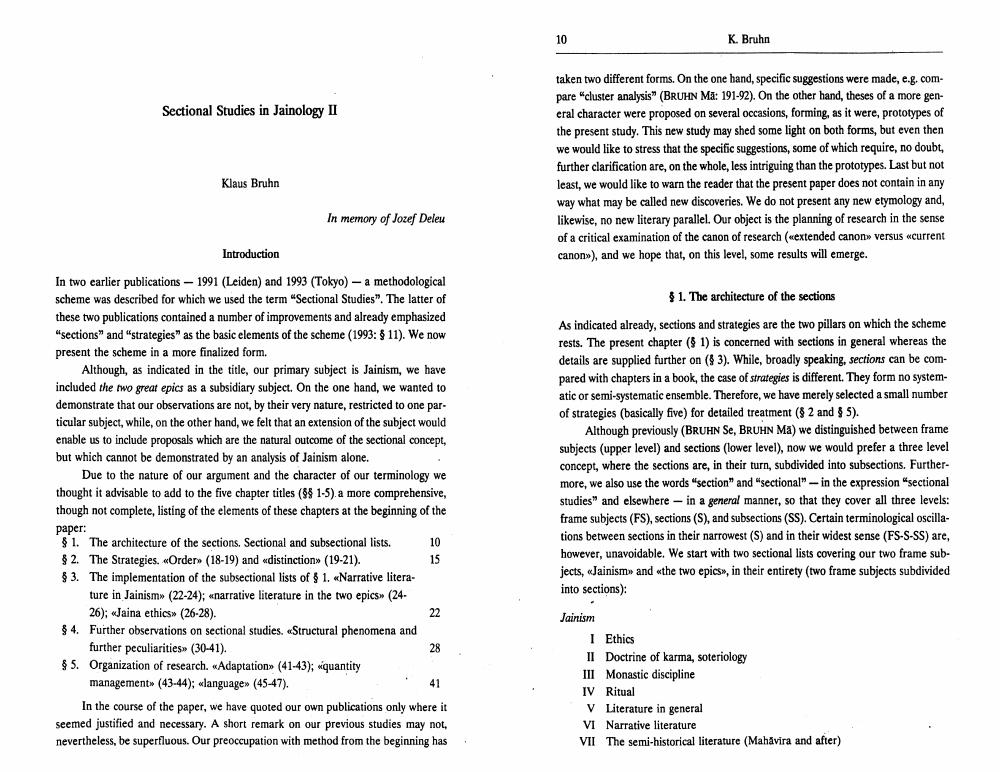________________
K. Bruhn
Sectional Studies in Jainology II
taken two different forms. On the one hand, specific suggestions were made, e.g.com pare "cluster analysis" (BRUHN Ma: 191-92). On the other hand, theses of a more gencral character were proposed on several occasions, forming, as it were, prototypes of the present study. This new study may shed some light on both forms, but even then we would like to stress that the specific suggestions, some of which require, no doubt, further clarification are on the whole, less intriguing than the prototypes. Last but not least, we would like to warn the reader that the present paper does not contain in any way what may be called new discoveries. We do not present any new etymology and, likewise, no new literary parallel. Our object is the planning of research in the sense of a critical examination of the canon of research («extended canon versus current canons), and we hope that, on this level, some results will emerge.
Klaus Bruhn
In memory of Jozef Deleu
Introduction
$1. The architecture of the sections
In two earlier publications - 1991 (Leiden) and 1993 (Tokyo) - a methodological scheme was described for which we used the term "Sectional Studies". The latter of these two publications contained a number of improvements and already emphasized "sections" and "strategies" as the basic elements of the scheme (1993: $ 11). We now present the scheme in a more finalized form.
Although, as indicated in the title, our primary subject is Jainism, we have included the two great epics as a subsidiary subject. On the one hand, we wanted to demonstrate that our observations are not, by their very nature, restricted to one par ticular subject, while, on the other hand, we felt that an extension of the subject would enable us to include proposals which are the natural outcome of the sectional concept, but which cannot be demonstrated by an analysis of Jainism alone.
Due to the nature of our argument and the character of our terminology we thought it advisable to add to the five chapter titles (99 1-5) a more comprehensive, though not complete listing of the elements of these chapters at the beginning of the
As indicated already, sections and strategies are the two pillars on which the scheme rests. The present chapter (1) is concerned with sections in general whereas the details are supplied further on (43). While, broadly speaking, sections can be compared with chapters in a book, the case of strategies is different. They form no system atic or semi-systematic ensemble. Therefore, we have merely selected a small number of strategies (basically five) for detailed treatment ($ 2 and 95).
Although previously (BRUHN SE, BRUHN Ma) we distinguished between frame subjects (upper level) and sections (lower level), now we would prefer a three level concept, where the sections are in their turn, subdivided into subsections. Furthermore, we also use the words "section" and "sectional" - in the expression sectional studies and elsewhere - in a general manner, so that they cover all three levels: frame subjects (FS), sections (S), and subsections (SS). Certain terminological oscillations between sections in their narrowest (S) and in their widest sense (FS-S-SS) are, however, unavoidable. We start with two sectional lists covering our two frame subjects, «Jainism and the two epics, in their entirety (two frame subjects subdivided into sections):
paper:
$1. The architecture of the sections Sectional and subsectional lists. 10 $ 2. The Strategies. «Order (18-19) and distinction» (19-21).
15 83. The implementation of the subsectional lists of $1. «Narrative litera
ture in Jainism» (22-24): «narrative literature in the two epics (24.
26): «Jaina ethics (26-28). $ 4. Further observations on sectional studies. «Structural phenomena and
further peculiarities» (30-41). $5. Organization of research. "Adaptation (41-43); quantity
management (43-44); language (45-47).
In the course of the paper, we have quoted our own publications only where it seemed justified and necessary. A short remark on our previous studies may not, nevertheless, be superfluous. Our preoccupation with method from the beginning has
Jainism
1 Ethics 11 Doctrine of karma, soteriology III Monastic discipline IV Ritual
V Literature in general VI Narrative literature VII The semi-historical literature (Mahavira and after)




